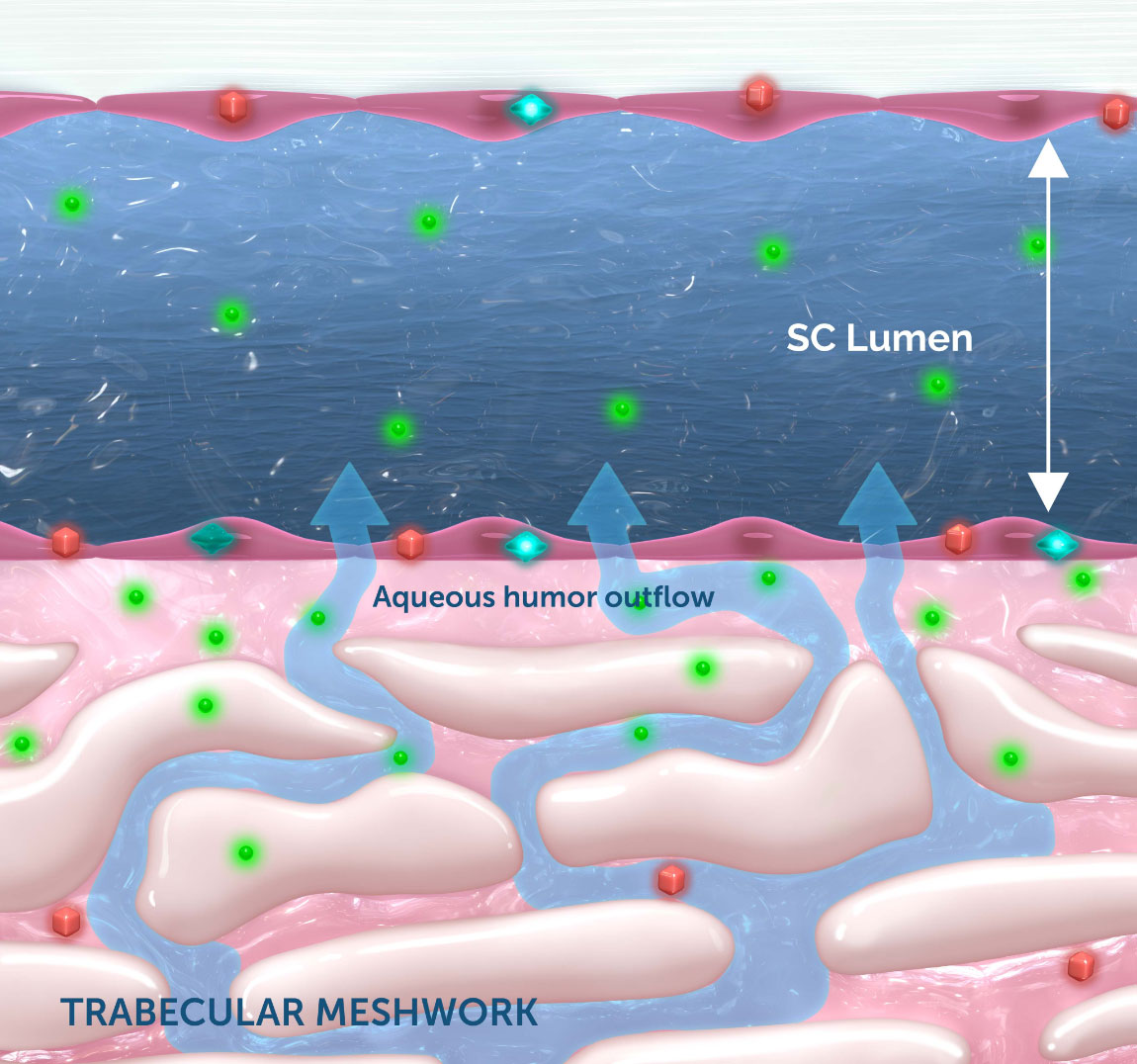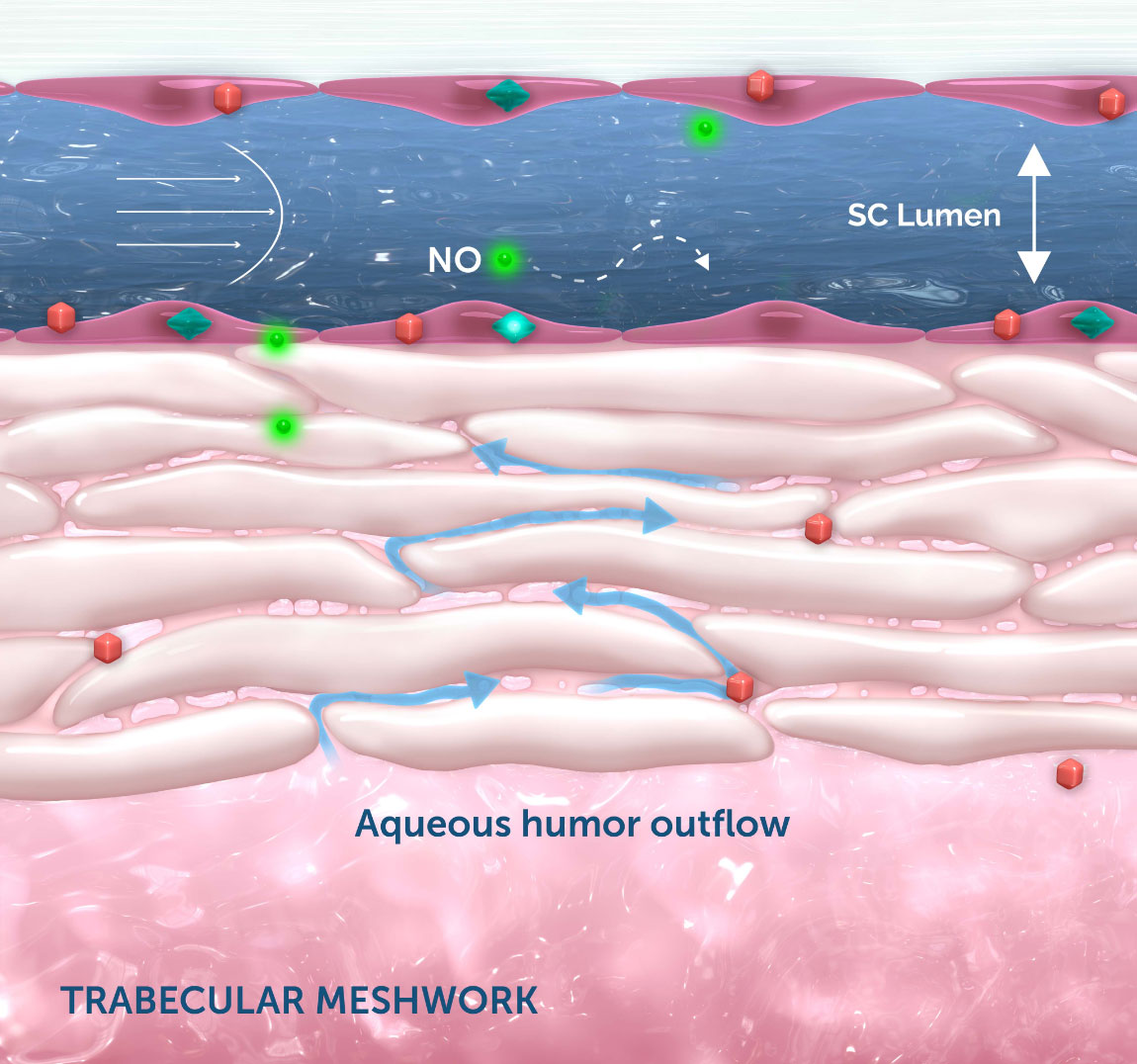
This site is intended for US healthcare professionals. SIGN UP
A pathologic chain reaction:
From trabecular meshwork contraction to impaired conventional outflow
Aqueous humor outflow is heavily influenced by the dynamic elasticity and contractility of the TM and Schlemm’s canal.2,7
Increased TM and Schlemm’s canal tissue stiffness, cell contractility, and fibrosis are key contributing factors in elevated IOP and thus glaucoma. As with the vascular changes that lead to atherosclerosis, multiple factors such as age, oxidative stress, and genetics may play a role in this pathogenesis.3, 7-10
Aqueous humor outflow is heavily influenced by the dynamic elasticity and contractility of the TM and Schlemm’s canal.2,7
Increased TM and Schlemm’s canal tissue stiffness, cell contractility, and fibrosis are key contributing factors in elevated IOP and thus glaucoma. As with the vascular changes that lead to atherosclerosis, multiple factors such as age, oxidative stress, and genetics may play a role in this pathogenesis.3, 7-10
NITRIC OXIDE DEPLETION: A PATHOGENIC CYCLE IN GLAUCOMA2,5,6,8,11


- Nitric oxide depletion and chronic TM contraction have both been observed in glaucomatous eyes.
- TM contraction restricts aqueous outflow, leading to reduced shear stress and eNOS activity in Schlemm’s canal.
- Reduced eNOS activity lowers nitric oxide production.
- In turn, nitric oxide depletion prevents optimal TM relaxation, causing impaired conventional outflow.

Genetic studies confirm the importance
of nitric oxide signaling in ocular health3,12
HUMAN GENETIC STUDIES
Polymorphisms in the NOS3 gene, which encodes for endothelial nitric oxide synthase (eNOS), have consistently been associated with high-tension primary open-angle glaucoma (POAG). These results were later confirmed in large, population-based, case-control studies.13,14
As new horizons in glaucoma emerge, we’ll keep you pointed in the right direction.
Sign up to receive the latest updates and emerging scientific research.
References:
1. Polak K, Luksch A, Berisha F, Fuchsjaeger-Mayrl G, Dallinger S, Schmetterer L. Altered nitric oxide system in patients with open-angle glaucoma. Arch Ophthalmol. 2007;125(4):494-498. 2. Aliancy J, Stamer WD, Wirostko B. A review of nitric oxide for the treatment of glaucomatous disease. Ophthalmol Ther. 2017;6(2):221-232. 3. Reina-Torres E, De Ieso ML, Pasquale LR, et al. The vital role for nitric oxide in intraocular pressure homeostasis. Prog Retin Eye Res. 2021;83:100922. 4. Braunger BM, Fuchshofer R, Tamm ER. The aqueous humor outflow pathways in glaucoma: a unifying concept of disease mechanisms and causative treatment. Eur J Pharm Biopharm. 2015;95(Pt B):173-181. 5. Galassi F, Renieri G, Sodi A, Ucci F, Vannozzi L, Masini E. Nitric oxide proxies and ocular perfusion pressure in primary open angle glaucoma. Br J Ophthalmol. 2004;88(6):757-760. 6. Doganay S, Evereklioglu C, Turkoz Y, Er H. Decreased nitric oxide production in primary open-angle glaucoma. Eur J Ophthalmol. 2002;12(1):44-48. 7. Stamer WD, Acott TS. Current understanding of conventional outflow dysfunction in glaucoma. Curr Opin Ophthalmol. 2012;23(2):135-143. 8. Ashpole NE, Overby DR, Ethier CR, Stamer WD. Shear stress-triggered nitric oxide release from Schlemm’s canal cells. Invest Ophthalmol Vis Sci. 2014;55(12):8067-8076. 9. Vahabikashi A, Gelman A, Dong B, et al. Increased stiffness and flow resistance of the inner wall of Schlemm’s canal in glaucomatous human eyes. Proc Natl Acad Sci U S A. 2019;116(52):26555-26563. 10. Saccà SC, Pulliero A, Izzotti A. The dysfunction of the trabecular meshwork during glaucoma course. J Cell Physiol. 2015;230(3):510-525. 11. Stamer WD, Lei Y, Boussommier-Calleja A, Overby DR, Ethier CR. eNOS, a pressure-dependent regulator of intraocular pressure. Invest Ophthalmol Vis Sci. 2011;52(13):9438-9444. 12. Rasmussen CA, Kaufman PL. Trabecular meshwork and outflow. Glaucoma Now. 2013;(1):5-8. 13. Tunny TJ, Richardson KA, Clark CV. Association study of the 5’ flanking regions of endothelial-nitric oxide synthase and endothelin-1 genes in familial primary open-angle glaucoma. Clin Exp Pharmacol Physiol. 1998;25(1):26-29. 14. Kang JH, Wiggs JL, Rosner BA, et al. Endothelial nitric oxide synthase gene variants and primary open-angle glaucoma: interactions with sex and postmenopausal hormone use. Invest Ophthalmol Vis Sci. 2010;51(2):971-979. 15. Lei Y, Zhang X, Song M, Wu J, Sun X. Aqueous humor outflow physiology in NOS3 knockout mice. Invest Ophthalmol Vis Sci. 2015;56(8):4891-4898. 16. Buys ES, Ko YC, Alt C, et al. Soluble guanylate cyclase a1-deficient mice: a novel murine model for primary open angle glaucoma. Ann Neurosci. 2013;20(2):65-66.








